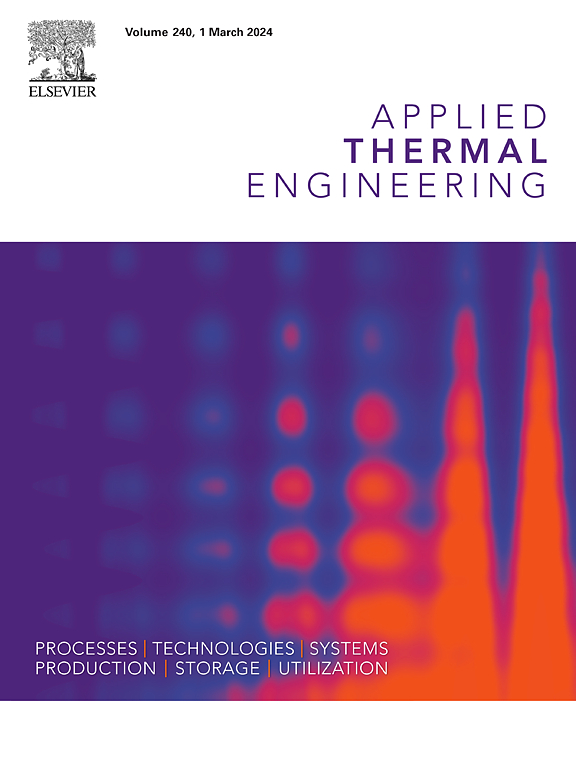Heat transfer characteristics of Taylor flow in a bottom-heated square microchannel: A 3D conjugate heat transfer numerical study
IF 6.1
2区 工程技术
Q2 ENERGY & FUELS
引用次数: 0
Abstract
The heat transfer mechanisms of Taylor flow in rectangular microchannels under asymmetric heating conditions remain incompletely understood. In this work, a three-dimensional conjugate heat transfer numerical simulation method is developed, which can achieve different Taylor flow distribution characteristics by modulating the second-phase volume fraction at the inlet boundary. Using this method, the heat transfer characteristics of gas–liquid Taylor flow in a rectangular channel under asymmetric bottom heating conditions were systematically studied for the first time. The simulation results show good agreement with our previous experimental results, verifying the reliability of the model. Heat transfer paths within bubbles and liquid slugs under bottom heating conditions were analyzed in detail based on three-dimensional velocity and temperature fields. The local Nusselt number distributions for single-phase flow and Taylor flow at various typical locations within the rectangular microchannel are compared, and it is found that the heat transfer enhancement effect of Taylor flow is evident throughout the entire channel. The heat transfer associated with leakage flow at channel corners has been investigated, revealing that the leakage flow in gas–liquid systems is characterized by low velocity and non-uniform distribution. The formation mechanism of the localized vortex at the tail of the bubble and its impact on heat transfer in the entire liquid film region were analyzed. A comprehensive investigation was conducted on the three-dimensional recirculation flow field distribution characteristics of Taylor flow in rectangular microchannels and the intrinsic mechanisms of heat transfer enhancement by short slugs. It was found that the velocity distribution within the short slug no longer conforms to the classical Poiseuille-flow profiles, and the “stagnant heat zone” in the bubble region disappears. Under the conditions of constant void fraction and mixture velocity, reducing the slug length by 60% decreases the average absolute recirculation time within the slug by approximately 53.2 % and increases the Nusselt number by 34 %.
底加热方形微通道泰勒流的传热特性:三维共轭传热数值研究
不对称加热条件下矩形微通道泰勒流的换热机理尚不完全清楚。本文提出了一种三维共轭换热数值模拟方法,该方法通过调节进口边界的第二相体积分数来实现不同的泰勒流分布特性。利用该方法,首次系统地研究了不对称底加热条件下矩形通道内气液泰勒流的换热特性。仿真结果与实验结果吻合较好,验证了模型的可靠性。基于三维速度场和温度场,详细分析了底部加热条件下气泡和液塞的传热路径。对比了矩形微通道内不同典型位置的单相流和泰勒流的局部努塞尔数分布,发现泰勒流的强化换热作用在整个通道内都很明显。研究了泄漏流在通道拐角处的传热特性,揭示了泄漏流在气液体系中具有低速和非均匀分布的特点。分析了气泡尾部局部涡的形成机理及其对整个液膜区域换热的影响。对矩形微通道Taylor流的三维再循环流场分布特征及短段塞强化换热的内在机理进行了全面研究。研究发现,短段塞内的速度分布不再符合经典的泊塞叶流分布,气泡区域的“滞热区”消失。在一定空隙率和混合速度的条件下,将段塞长度缩短60%,段塞内平均绝对再循环时间减少约53.2%,努塞尔数增加34%。
本文章由计算机程序翻译,如有差异,请以英文原文为准。
求助全文
约1分钟内获得全文
求助全文
来源期刊

Applied Thermal Engineering
工程技术-工程:机械
CiteScore
11.30
自引率
15.60%
发文量
1474
审稿时长
57 days
期刊介绍:
Applied Thermal Engineering disseminates novel research related to the design, development and demonstration of components, devices, equipment, technologies and systems involving thermal processes for the production, storage, utilization and conservation of energy, with a focus on engineering application.
The journal publishes high-quality and high-impact Original Research Articles, Review Articles, Short Communications and Letters to the Editor on cutting-edge innovations in research, and recent advances or issues of interest to the thermal engineering community.
 求助内容:
求助内容: 应助结果提醒方式:
应助结果提醒方式:


